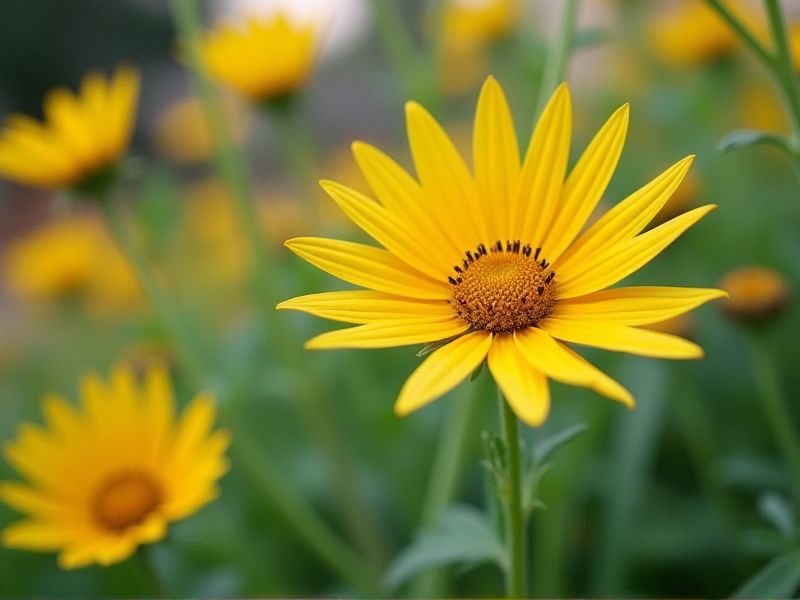
Perennial plants known for their drought tolerance include lavender, sedum, and cone flowers. These species thrive in various soil types and require minimal maintenance once established. Incorporating these plants into your garden not only conserves water but also promotes biodiversity by attracting pollinators such as bees and butterflies. Many of these perennials are also hardy in a range of climates, making them versatile choices for sustainable landscaping. When selecting drought-resistant perennials, consider your local climate and soil conditions to ensure optimal growth and resilience.
List of some Perennial plants that require little water
- Lavender (Lavandula)
- Agave (Agave)
- Coneflower (Echinacea)
- Yarrow (Achillea)
- Blanket Flower (Gaillardia)
- Russian Sage (Perovskia atriplicifolia)
- Sedum (Sedum)
- Hens and Chicks (Sempervivum)
- Blue Fescue (Festuca glauca)
- Lantana (Lantana)
Important things about Perennial plants that require little water
Drought Tolerance
Perennial plants known for their drought tolerance, such as Agave, Sedum, and Lavender, thrive in arid conditions, making them ideal for sustainable landscaping. These species develop deep root systems that efficiently access moisture from the soil, allowing them to survive long periods without rainfall. By selecting drought-resistant perennials, you can create a low-maintenance garden that conserves water and reduces irrigation costs. Incorporating these plants not only enhances your landscape's aesthetic appeal but also promotes ecological balance by supporting local pollinators like bees and butterflies.
Deep Root Systems
Perennial plants with deep root systems, such as black-eyed Susans and coneflowers, are specifically adapted to thrive in arid environments by accessing moisture from deeper soil layers. These plants not only enhance soil health but also maintain biodiversity, attracting pollinators like bees and butterflies. When cultivating a garden with low-water-perennial plants, incorporating mulching can further reduce evaporation and improve water retention. Your choice of deep-rooted perennials can lead to a sustainable and low-maintenance landscape that conserves water while providing vibrant blooms year after year.
Native Species Advantage
Perennial plants, particularly native species, thrive in arid climates with minimal water requirements. These plants have evolved adaptations that enable them to survive and flourish with limited moisture, making them ideal for sustainable gardening and landscaping. By incorporating native perennials into your garden, you not only reduce water usage but also support local ecosystems through improved soil health and increased biodiversity. Understanding the specific native species suited for your region can further enhance the resilience of your garden while promoting environmental conservation.
Seasonality
Perennial plants that require minimal water thrive in various seasonal conditions, making them ideal for drought-prone gardens. During spring, these resilient plants emerge from dormancy, showcasing vibrant blooms and lush foliage, while their deep root systems enable them to access moisture from deeper soil layers. In summer, many drought-tolerant perennials, such as sedums and lavender, display their adaptability by flourishing despite high temperatures and low rainfall. Focusing on fall and winter, these plants not only conserve water but also provide attractive textures and colors, enriching your landscape year-round.
Low Maintenance
Perennial plants such as lavender, sedum, and echinacea thrive with minimal water, making them ideal for low-maintenance gardens. These drought-resistant species not only resist dry conditions but also enhance your landscape with vibrant colors and delightful fragrances. Incorporating native plants like coneflowers can further boost your garden's sustainability, attracting pollinators and promoting local biodiversity. Choosing these resilient perennials ensures a flourishing garden that conserves water and requires less upkeep year-round.
Soil Improvement
Perennial plants, such as lavender, sedum, and native grasses, thrive in arid conditions and contribute to soil improvement by enhancing soil structure and fertility. These drought-tolerant plants develop extensive root systems that stabilize the soil, reduce erosion, and promote the infiltration of water, fostering a healthier ecosystem. Incorporating these perennials into your landscape design not only conserves water but also supports pollinators, enriching biodiversity. By choosing these resilient plants, you can create an aesthetically pleasing environment while effectively enhancing the soil's overall health and sustainability.
Pest Resistance
Perennial plants, such as lavender, sedum, and yarrow, are excellent choices for gardens seeking pest resistance while conserving water. These species tend to possess natural defenses against common pests like aphids and spider mites, reducing the need for chemical treatments. With their deep root systems, they successfully access moisture from the soil, thriving in drought conditions. Incorporating these resilient plants into your landscape design not only enhances biodiversity but also promotes sustainable gardening practices.
Variety Of Types
Perennial plants, such as succulents and drought-tolerant native species, thrive in arid environments with minimal water needs. Notable examples include Sedum, which features fleshy leaves that store moisture, and Lavender, celebrated for its fragrant blooms and resilience to dry conditions. Incorporating these plants into your garden can enhance its aesthetic while reducing irrigation efforts, making them ideal for eco-conscious gardeners. By choosing these water-efficient perennials, you not only conserve resources but also promote biodiversity and support local wildlife.
Attract Pollinators
Perennial plants that require minimal water are essential for attracting pollinators, contributing to a vibrant garden ecosystem. Varieties like Lavender (Lavandula), Coneflower (Echinacea), and Black-eyed Susan (Rudbeckia) thrive in dry conditions while providing nectar and pollen that appeal to bees, butterflies, and other beneficial insects. Incorporating these drought-tolerant perennials not only conserves water but also enhances the visual appeal of your landscape with their colorful blooms. By selecting such plants, you create a low-maintenance yet pollinator-friendly environment that supports biodiversity.
Environmental Benefits
Perennial plants, such as lavender, sedum, and coneflowers, are ecological powerhouses that thrive with minimal water, making them ideal for sustainable gardening. These drought-resistant species not only conserve water resources but also contribute to soil health by preventing erosion and enhancing biodiversity. By incorporating these plants into your garden, you can create a vibrant ecosystem that supports pollinators like bees and butterflies. Furthermore, their resilience reduces the need for chemical fertilizers and pesticides, promoting a healthier environment.
